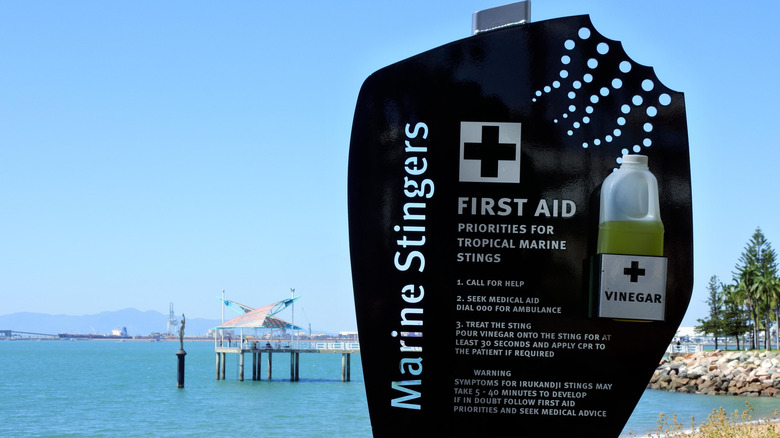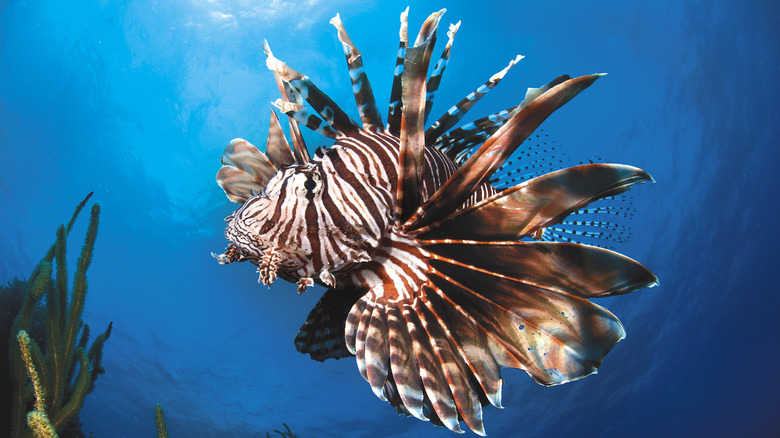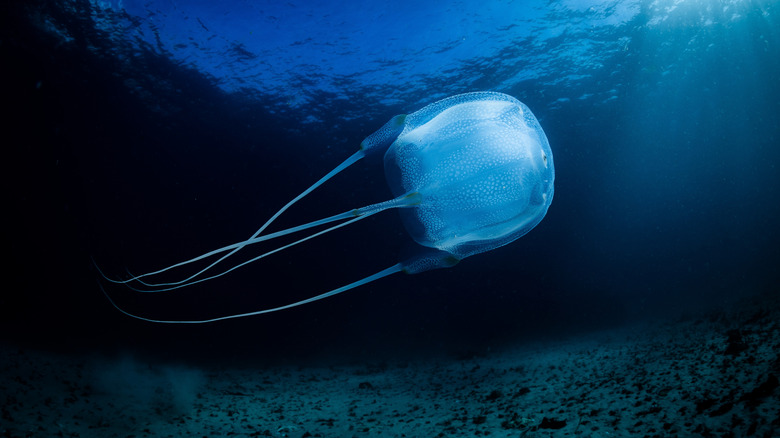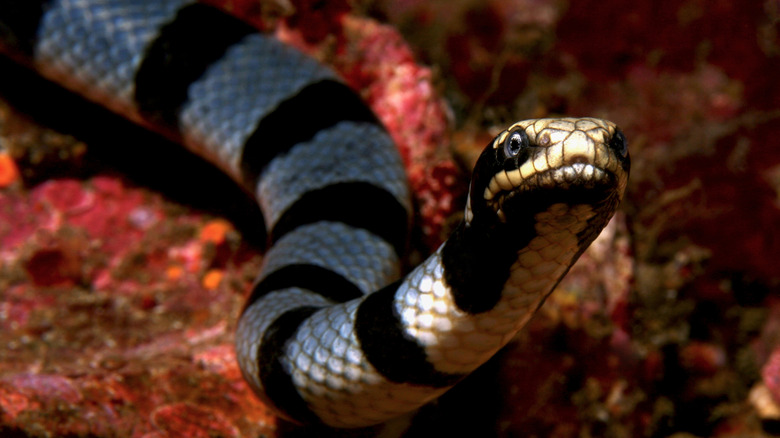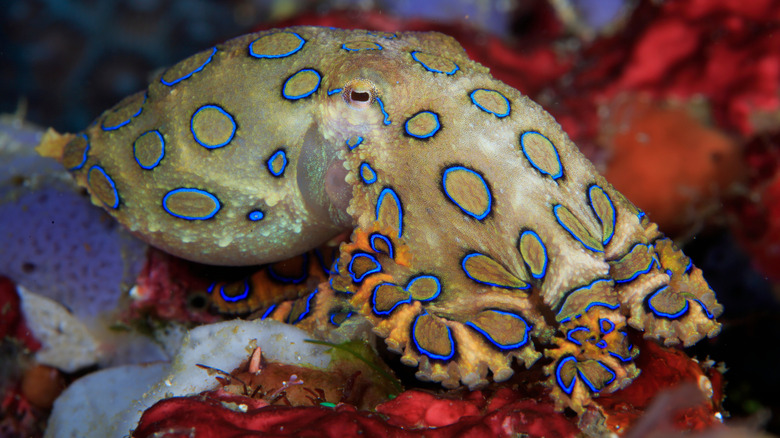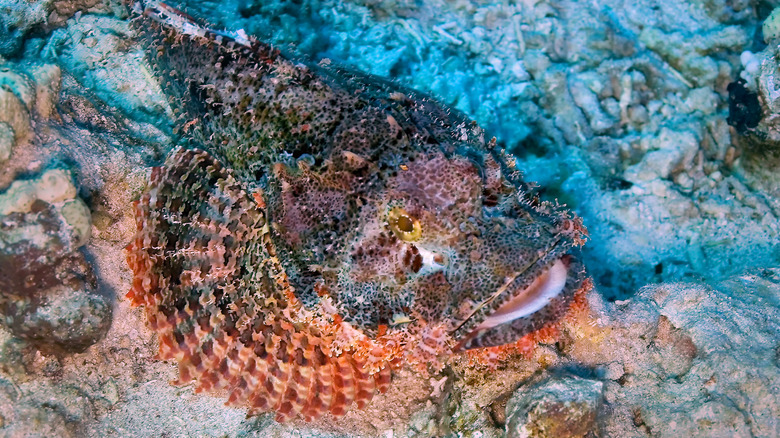Beware These Venomous Creatures During Your Next Trip To The Ocean
We may receive a commission on purchases made from links.
The world's oceans are full of interesting and amazing creatures. However, not all of them are safe to encounter. While most who swim, snorkel, or dive in the ocean are familiar with threats such as dangerous types of sharks, they may not be aware that some of the smaller sea creatures can also inflict serious harm and even death. Ironically, some of the world's most dangerous ocean creatures are also some of the most beautiful. But, although these animals are mesmerizing to look at, you should avoid contact with them at all costs.
When it comes to venomous creatures, every ocean has some. Worldwide, there are more than 1,200 different venomous fish — that's not counting other toxic animals such as jellyfish, sea urchins, octopus, and other species. Given that the potency of the venom possessed by these marine animals varies, they do not all pose a risk to humans. However, others carry lethal levels of venom, while a good deal more are potent enough to cause a serious reaction. Many of these animals are found in several oceans and some have been expanding their range. With that in mind, you should stay on alert for these venomous creatures during your next trip to the ocean.
Lionfish are beautiful but dangerous
Lionfish are one of those sea creatures that look otherworldly, with their long, wispy dorsal fins, fan-shaped pectoral fins, and starkly contrasting stripes. While they are actually from this world, they have spread to a number of the Earth's oceans where they weren't originally found. In fact, lionfish are considered to be one of the most invasive species in saltwater. Its native range includes portions of the South Pacific and Indian oceans. However, it has spread to various parts of the Atlantic Ocean off the coast of the United States, as well as the Caribbean Sea and Gulf of Mexico.
Regardless of where they are encountered, lionfish present a very real danger. The spines of lionfish fins contain a very toxic venom that can produce a wide range of symptoms ranging from excruciating pain to paralysis. This venom is delivered if the spine of the fin punctures skin, so most injuries occur while people, such as fishermen, snorkelers, or divers, are handling them.
Ironically, despite being venomous, lionfish are also delicious. As a way to try and temper the population explosion of them in their non-native range, fishermen and divers are encouraged to harvest all they can. A number of commercial fishing operations also target lionfish to supply restaurants with these sought-after fillets. However, despite these efforts, lionfish numbers continue to climb outside their native range.
Box jellyfish are the most dangerous type of jellyfish
Box jellyfish have a fearsome reputation among beachgoers. This is not without justification. Over 50 species of box jellyfish found throughout the world's warm water oceans are capable of delivering an incredibly painful sting. A handful of these box jellies are also able to inject a lethal dose of venom to anyone unlucky enough to brush against one. Because of this, box jellies are considered the most dangerous type of jellyfish.
Deadly varieties of these creatures are found in the Indian and Southern Pacific oceans. The most infamous of these is the Australian box jellyfish. In fact, Australian box jellyfish are generally thought to be the most venomous marine creature. If the thought of becoming entangled in their toxic tentacles isn't terrifying enough, box jellyfish can also swim at speeds of nearly four knots, which equates to a little over four-and-a-half miles per hour. While this may not sound overwhelmingly impressive, consider the average human swims two miles per hour.
Although box jellyfish are not known to swim after or target humans, the fact they can quickly cover so much water makes the likelihood of encountering one higher. In areas known to have box jellies, the only sure-fire way to avoid them is to stay out of the water, especially during what is referred to as "stinger season." This is a period of time when the number of jellyfish skyrockets near beaches. In Australia, it is typically November through May. If you do get in the water, wear coverings such as wet suits or long-sleeved clothing. It can also be helpful to lather up with Safe Sea anti-jellyfish sting sunblock and always carry vinegar in case you do get stung by a jellyfish.
Sea snakes have extremely potent venom
Although most people associate snakes with deserts, forests, and swamps, there are dozens of species of sea snakes that inhabit oceans around the world. Several of these are considered to be among the most dangerous snakes on Earth. In fact, some sea snakes are more than four times as venomous as land-living cobras. Luckily, sea snakes have a fairly mild temper and don't often attack. Additionally, unlike many dangerous snakes living on land, sea snakes have fairly short fangs — too short to penetrate thick garments like wet suits.
Not to be confused with eels, which are fish, sea snakes are reptiles, just like snakes found on dry land. This means they must breathe air and so are sometimes spotted on the surface. Most prefer shallow, warm waters and are typically found in the Indian Ocean as well as portions of the South Pacific. A few species spend short periods on land, but the vast majority remain in the water throughout their lifetime.
Bites from sea snakes can cause a variety of issues, including muscle stiffness, weakness, and even paralysis. It can also cause nausea, vomiting, and drowsiness. If you are bitten, you should get out of the water immediately to prevent drowning, begin first aid, and immediately seek medical attention.
Blue-ringed octopus pack a deadly dose of venom
Every type of octopus packs some level of venom. However, it is one of the smallest octopus in the world that has the highest level of toxicity. The average blue-ringed octopus is roughly the size of a golf ball, but within its tiny body is enough venom to kill over two dozen people. Even more alarming is the fact that there is no antidote. Your only hope for survival if bitten by a blue-ringed octopus is immediate artificial respiration, as the toxin quickly shuts down muscles throughout the body.
Beyond its size, the blue-ringed octopus is known for an appearance that belies its deadly nature. The iridescent blue rings that give this octopus its name, are sprinkled over its mottled brown body. While the blue rings are quite stunning and add to the beauty of this diminutive sea creature, they are also meant as a warning sign. When the blue rings are at their brightest, the octopus is signaling its intentions to attack.
There are believed to be close to a dozen species of blue-ringed octopus, all of which live in the Pacific and Indian oceans. They are commonly found in tidal pools. However, if you do see one, never pick it up or handle it. Instead, just admire it from a safe distance.
Beware of stepping on a stonefish
Unlike most creatures on this list, stonefish are considered to be among the more attractive marine animals, to put it politely. While they might not be thought of as one of the most beautiful creatures in the sea, they are the world's most venomous fish and one of nature's deadliest ocean creatures. They are also among the most adept at camouflage and staying hidden, making them difficult to see for both their prey and humans alike.
There are five types of stonefish, most of which live in the Indo-Pacific region, although some have been found in the Caribbean Sea. Like other fish found in their family, such as lionfish and scorpionfish, stonefish carry their toxic venom in the spines of their fins. If these spines puncture the skin, the venom is injected into the victim. Most often these injuries occur when people inadvertently step on unseen stonefish.
A sting from a stonefish can cause difficulty breathing, low blood pressure, shock, nausea and vomiting, numbness, paralysis, and seizures. If you do happen to get stung by a stonefish, the first step is to get out of the water. Then, apply direct pressure to stop bleeding before soaking the wound area in the hottest water you can stand and seeking medical attention.
